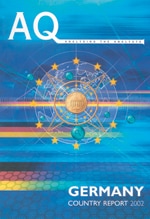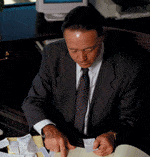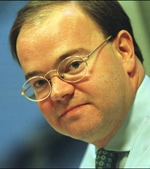
Research Under the Microscope
Analysts are coming under analysis, and it can be a disconcerting experience.
The equity analysts job has become a great deal tougher in the past three years. A sustained bear market has meant pressures from all sides: within investment banks it has been a story of remorseless cost cutting, redundancies and slashed bonuses. From outside, disgruntled investors and zealous regulators have been gunning (sometimes quite literally) for the analysts. Now comes anotherat times unwelcomepressure: the scrutiny of research by third parties.
In the past, analysts were seldom held accountable for their forecasts and recommendations. Now, it is standard practice for all research distributed in the US to carry charts showing the history of an analysts recommendations and the corresponding movements in the share price. A central database is to be set up in the US to track these as part of the global research settlement initiated by New York Attorney Eliot Spitzers investigations.
Private companies are already providing some of this service. London-based AQ (Accuracy Quotient) has been tracking analysts earnings per share (eps) forecasts since 1998, using raw data from Thomson Financial, the biggest provider of earnings estimate data. The ability to predict company eps accurately is, we have maintained, one sign of an analysts understanding of a companys fundamentals.
For investors, however, an analysts ability to pinpoint an eps number to the third decimal place is not always as useful as knowing whether a buy, hold or sell recommendation was right or not. Spitzers investigations revealed a clear bias toward positive recommendationsa pattern that UK regulator the Financial Services Authority argues is mirrored in the market it oversees. Thats pushed analysts recommendations to center stage in the quest for independent research. In order to meet that demand AQ has now moved into the monitoring of recommendations in a new report, RQ. First published in May this year RQ tracks analysts recommendations against the performance of the stocks they choose. Of course, were not the only ones who have recognized the importance of this service.
In the US, the scrutiny of recommendations has been led by San Fransicso-based Starmine, which ranks individual analysts and highlights those with 5-Star performance. In Europe, the Swiss Association of Financial Analysts has created a computer program, the Information Standard for Analysts (ISFA), that allows users to determine whether analysts recommendations add value or not.
Analysts will also find themselves being monitored more closely from within their own firms. Heads of research have tools at their fingertips that enable them to see which of their analysts recommendations have performed bestand worst. They are, in many cases, combining this with new systems designed to eliminate the bias in research by forcing analysts to match the number of buy and sell recommendations. This was a method that HSBC pioneered in the UK under Mark Brown, who has now returned to ABN AMRO as European head of research. Other housessuch as Frances Aurel Levenare forcing analysts to come off the fence by abolishing the hold recommendation (often seen as nothing more than a parking lot for neglected stocks).
For analysts who fall in love with their stocks or who go in fear of the wrath of a company (or their own corporate finance department) when marking a stock down from a buy to a sell, these will be hard times. But for the companies monitoring the processand for the ultimate investorsthere are promising times ahead.
Graham Field

Fund Managers: Cant Pay, Wont Pay
An industry finds its cost structure under attack.
We used to receive around two feet of research material a day, says one New York hedge fund manager. In 2000 we were so swamped by the stuff, we even employed a temp that summer to write to the banks sending it, asking them to stop. But they still kept on sending it in.
To fund managers all over the world, the tale is familiar. The sell side wants to woo the buy side. To try and do so it swamps its would-be customers with freebut expertanalysis.
And of course expert adviceas both parties in the business knowisnt free. Wooing costs money, and that has to come from executing the foreign exchange, interest rate, custody or whatever business that needs to be done.
The problem that everyone involved in providing independent research has to break through is this barrier of cost, says Nick Hill, managing director of London-based Independent Research. At present fund managers are used to getting everything for free.
Being free is of course a misnomer, adds Hill. The banks claw back the cost of their research in transaction chargesand until that mindset changes, independent research will always be at the margins.
Although Hill and all the independent houses interviewed for this article believe that this mindset will change, one big problem is the marketing.
Being heard above the noise of the prolific big banks is difficult. And especially so without the deep pocketsofa Citibank, a Merrill Lynch or a Goldman Sachs.
Most fund managers dont complain about the volumes of words that come across the deskmost say that it is part of the territory. But what they are looking for is material that gives them a cutting edge.
This almost inevitably means that for research houses to get listened to they have to specialize. Our core expertise is the European Central Bank, says Allan Saunderson, chairman of Eurozone Advisors, a Frankfurt headquartered consultancy. And we go in and market ourselves on our inside track knowledge of the ECB. People are fed up with Boston or London consensus economicsthe herd view is neither safe nor necessarily profitable.
One response to the challenge of filtering out the possible bias of external banks has been to move research in house. Some fund managers such as Fidelity have scrapped external research completely.
But this is a costly business. Most experts consider that to have a reasonable stock analysis service that you need to have an absolute minimum of around 35 analysts, and to do it well should have roughly twice that figure.
But with a difficult economic climatefund managers are having a particularly difficult time trying to create anything approaching a double digit return as interest rates fall to 50-year lowsthe pressureonfor the whole industry to cut costs.
And, of course, this is a double-edged sword for independent researchers. Some are profiting from cost cuttingininvestment banks. If they can deliver a particular expertise in a cost-effective manner, they are likely to get hired. If not, as thein-houseresearch units get axed so do the budgets to pay for the specialists.
Michael Halls
Going It Alone
Independent research houses are booming.
Economic analysis by herd instinct. That could well be a fair description of most of the research material produced in the worlds financial centers.
Over the past decade the pressures on analysts to conformnot to make waves or be involved in law suits and to keep to corporate templateshas been enormous, says Jamie Stewart, a director at London brokerage, the Eden Group. Its been emasculated. The research were receiving nowadays could as equally been written in Sydney as in San Francisco.
Ten years ago it was possible to arbitrage two different views on interest rates and currency movementsdepending whether you were in New York or Londonat at least one well-known US investment bank.
But no longer. Few bemoan the crumbling of the research culture of the most recent stock market boom, which was all-too-often investment banking-driven. But end users says argue that banks attempts to navigate the new regulatory landscape have made caution a watchword and resulted in research that reads like its been pushed through a sausage machine.
Few of the characters and stars of yesteryear would be allowed to thrive nowadays. Thats goodmany of the standout analysts of recent years were revealed as pumped-up cheerleaders. But its bad too. A growing number of analysts are now finding banking culture a straitjacket, and are jumping ship to form or join independent research houses. Of course, its been done before.
Take one-time London-based analyst Terry Smith, now CEO of independent brokerage Collins Stewart. As an analyst at BZW in the 1980s he recommended dumping shares in parent bank Barclays. He kept his job. He wasnt so lucky the next time.
Despite being voted best bank analyst for six years in the 1980s he was fired from Swiss banking giant UBS for his views in 1992. His crime? He wrote a book naming and shaming firms that were using creative accounting to inflate their profits.
His revenge was to set up on his own research house-cum-brokerage, which has since gone on to roil a series of top companies with its independent and, it has to be said, provocative research. Hes been proved right often enoughover entertainment giant Vivendi, for example, or telecom disaster Marconito have attracted a growing band of followers. Hedge funds are keen listeners, as his cashflow return on investment has proved useful in signaling profitable stock shorting opportunities.
Most of the new operations have yet to reach this mark. The first thing you notice about them is their size. Frequently they start as a one-man band, who then hire ex-colleagues. Invariably, the key figure will have been a senior figure at a sell-side institution with a reputation they can trade on. Very rarely does the number of employees reach double figures.
Part of the reason for the size is the set-up cost. The largest US banks can employ as many as 200 analystsalmost all of them stockin their research departments, says a London based consultant. Given that their average salary is going to be around $100,000 and the cost of maintaining their desk about the same again, youre talking about fixed overheads of around $400 million.
Because they cannot compete with the full range of services that a global bank can provide, independent research boutiques are inevitably specialists.
This is the way forward, says Eden Groups Stewart. Its similar to going to a shopping mall. You buy your regular household goods in the supermarket but you go to the specialist liquor store when you want to buy fine wines. So too will be research.
But analysis by herd instinct shouldnt be dismissed totally.
Some research houses say their output is enhanced by working closely with the markets. Were not rumor-mongering but capturing the flavour of what traders are thinking about, says Ray Attrill, research director at 4Cast, a London-based economic consultancy. And that in itself can be as useful to investors as a 200 page report.
Michael Halls

ResearchComing From a Trading Floor Near You
Tracking the direction of money flows is becoming an important research tool.
With hundreds of billions of dollars of cross-border trades being executed every day, a new form of research has emergedanalyzing these flows and using them as a predictive tool.
At the cutting edge of this analysis have been two banksCitibank, the largest foreign exchange trading bank in the world and State Street, one of the largest custodian banks.
The theory is simple. By analyzing trade flowshow much buying and selling of a product is going onanalysts are able to form a picture of supply and demand. That then gives an indication of where the prices should go: Is it a buy or a sell?
The flows, however, must be large to have anymeaning.Citigroup,whichexecutes between 10% to 15% of the trades in the $1 trillion a day foreign exchange market, is in an enormously strong positionincurrency analysis.
So, for example, over the last month we’ve been able to see two sides of the picture with dollar/yen, says Philip Brass, a vice president in Citigroups FX division. Market opinion has been that Bank of Japan intervention might not work. However, we saw Japanese corporates withdrawing from their normal selling of USD/JPY while Japanese real money investors were happily buying the dollarapparently in the expectation that intervention would work.
Knowing both sides of the supply and demand picture in a highly quantative format gives you a better angle on future price than simply watching the current noisy price action.
Its not just trading operations that generate enough activity to throw off patterns.
As a global custodian, State Street administers some $8 trillion of fund managers moneyand trades between 1 million and 10 million of securities a day on their behalf. That gives it considerable insight.
Our analysis is different from regular research in that were not offering straight buy or sell recommendations, says Simon Wilson-Taylor, head of Global Link, State Streets trading platform. Were offering our understanding of whats going on in the markets. How that is interpreted into an investment strategy is the clients responsibility.
AlthoughState Street produces written research, one of the key features of this analysis is that it is mostly seen online. Other custodian and trading banksBank of New York and Bank of Americaare also developing research capabilities linked to their trading flows.
One of the more unusual foreign exchange prediction research and analytics available comes from Olsen Group, a Swiss organization that has compiled almost 20 years of foreign exchange data. It has then cleaned and interpreted the data to produce a set of forecasting tools and research that it claims will invariably give an edge to FX trading. It has even produced an Internet trading platform, oanda.com, that has automated the findings.
So confident is he in its findings that on top of its trading platform, its founder Richard Olsen, an economist, has taken the unusual step of using his analytics to set up his own hedge fund.
Michael Halls

Credit Where Credits Due
The booming credit universe is providing rich pickings for providers of independent research.
If the change in fortunes for financial services companies has been a dip on a rollercoaster, then credit analysts have been sat in the last couple of carriages. With corporate bonds providing plumper revenues for many banks than other departments, credit research teams have been relatively safe from the threat of redundancyuntil recently. Increasingly, though, banks are questioning whether they can afford to keep these expensive teams. That question has been given added urgency by other shifts in the credit industry.
Worried over conflicts of interest, bond buyers are increasingly turning to independentcreditanalysis rather than relying on recommendations from the sell side of banks. We started this company knowing that institutional customers knew that the information provided to the them by the sell side was tainted, says Paul Ciasullo, an analyst at independent credit research team Creditsights in New York. It may be new to mom and pop unfortunately, but its not new to the institutions to which were selling our research.
Creditsights was founded in late 2000 by a handful of bond traders and analysts. Its since grown from a team of six to now over 25 analysts. Annual subscriptions to the companys research cost $12,000 per individual user. We have companies managing less than $10 million in assets with a couple of people taking a subscription, says Ciasullo, and we have companies with literally hundreds of billions of dollars buying the research for their entire research department.
The blurring of the boundaries between equity and credit markets is sparking growing interest in these services outside the traditional bond buying universe. Equity investors are increasingly looking to firms such as New York-based Gimme Credit to provide capital structure analysis. With the stockmarket flat, measures more traditionally valuable in pricing debtsize of cost bases and a companys ability to bring product growth through to the bottom linebulk larger for equity investors than in more gung-ho times.
With fixed income markets strong and bond volumes heavy investors workloads are going up. Even if rates begin to climb credit markets are likely to swell further in Europe and Asia. Fund managers in key countries such as the United Kingdom have been turning to bonds to provide greater certainty of return for maturing portfolios. Banks have become less certain a source of credit for the Continents treasurers.
In times gone past, bond buyers would have looked to bank research desks to do much of the heavy lifting. Now, theyre bolstering their own credit research capabilities. Weve really strengthened our team over the last year, says Rod Paris, head of fixed income at Standard Life Investments in Edinburgh, United Kingdom. The market has driven this development, he says, because theres been a significant increase in the size of our credit inventory. The company holds around 10 billion in credit products of one form or another, but Paris underlines that in terms of research there is free interchange between equity and credit analysis at the firm. The way we approach it we have to do a lot of primary research ourselves and develop our own ideas, which changes how we interact with the sell side strategists. and recommendationswhich tend not to be based on the holistic approach we have internally.
With investors often opting for independent research or doing it themselves, its the bank sell side that is being particularly hard-hit. Theres a widening pool of talent available, says Paris, referring to the many bankers that his company and those like him can now take their pick from.
Benjamin Beasley-Murray



